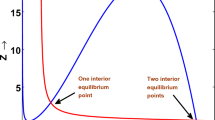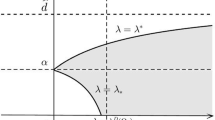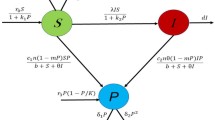Abstract
In this paper, a predator-prey model with nonmonotonic functional response is concerned. Using spectrum analysis and bifurcation theory, the bifurcating solution and its stability of the model are investigated. We discuss the bifurcation solution which emanates from the semi-trivial solution by taking the death rate as a bifurcation parameter. Furthermore, by fixed point’s index theory, the result of existence or nonexistence of positive steady states of the model is also obtained.
Similar content being viewed by others
References
Amann, H.: Fixed point equations and nonlinear eigenvalue problems in ordered Banach spaces. SIAM Rev. 18, 620–709 (1976)
Andrews, J.F.: A mathematical model for the continuous culture of microorganisms utilizing inhibitory substrates. Biotechnol. Bioeng. 10, 707–723 (1968)
Blat, J., Brown, K.J.: Bifurcation of steady-state solutions in predator-prey and competition systems. Proc. R. Soc. Edinburgh Sect. A 97, 21–34 (1984)
Blat, J., Brown, K.J.: Global bifurcation of positive solutions in some systems of elliptic equations. SIAM J. Math. Anal. 17, 1339–1352 (1986)
Brown, K.J.: Nontrivial solutions of predator-prey systems with small diffusions. Nonlinear Anal. 11, 685–689 (1987)
Bush, A.W., Cook, A.E.: The effect of time delay and growth rate inhibition in the bacterial treatment of wastewater. J. Theor. Biol. 63, 385–395 (1976)
Crandall, M.G., Rabinowitz, P.H.: Bifurcation, perturbation of simple eigenvalues and linearized stability. Arch. Ration. Mech. Anal. 52, 161–181 (1973)
Dancer, E.N.: On the indices of fixed points of mappings in cones and applications. J. Math. Anal. Appl. 91, 131–151 (1983)
Freedman, H.I.: Deterministic Mathematical Models in Population Ecology. Monographs and Textbooks in Pure and Applied Mathematics, vol. 57. Marcel Dekker, New York (1980)
Hsu, S.B.: On global stability of a predator-prey system. Math. Biosci. 39, 1–10 (1978)
Kooij, R.E., Zegeling, A.: Qualitative properties of two-dimensional predator-prey systems. Nonlinear Anal. 29, 693–715 (1997)
Li, L.G.: Coexistence theorems of steady states for predator-prey interacting systems. Trans. Am. Math. Soc. 305, 143–166 (1988)
Li, L.G., Logan, R.: Positive solutions to general elliptic competition models. Differ. Integral Equ. 4, 817–834 (1991)
Mckenna, P.J., Walter, W.: On the Dirichlet problem for elliptic systems. Appl. Anal. 21, 207–224 (1986)
Pang, P.Y.H., Wang, M.X.: Non-constant positive steady states of a predator-prey system with non-monotonic functional response and diffusion. Proc. Lond. Math. Soc. 88, 135–157 (2004)
Ruan, S.G., Xiao, D.M.: Global analysis in a predator-prey system with nonmonotonic functional response. SIAM J. Appl. Math. 61, 1445–1472 (2001)
Smoller, J.: Shock Waves and Reaction-Diffusion Equations, 2nd edn. Springer, New York (1999)
Sugie, J., Kohno, R., Miyazaki, R.: On a predator-prey system of Holling type. Proc. Am. Math. Soc. 125, 2041–2050 (1997)
Wu, J.H., Wei, G.S.: Coexistence states for cooperative model with diffusion. Comput. Math. Appl. 43, 1277–1290 (2002)
Xiao, D.M., Ruan, S.G.: Multiple bifurcations in a delayed predator-prey system with nonmonotonic functional response. J. Differ. Equ. 176, 494–510 (2001)
Yamada, Y.: Stability of steady states for prey-predator diffusion equations with homogeneous Dirichlet conditions. SIAM J. Math. Anal. 21, 327–345 (1990)
Author information
Authors and Affiliations
Corresponding author
Additional information
Supported by the National Science Foundation of China (10571115).
Rights and permissions
About this article
Cite this article
Jia, Y., Wu, J. & Nie, H. The Coexistence States of a Predator-Prey Model with Nonmonotonic Functional Response and Diffusion. Acta Appl Math 108, 413–428 (2009). https://doi.org/10.1007/s10440-008-9319-y
Received:
Accepted:
Published:
Issue Date:
DOI: https://doi.org/10.1007/s10440-008-9319-y
Keywords
- Predator-prey model
- Coexistence states
- Nonmonotonic functional response
- Bifurcation theory
- Fixed point index
- Stability




